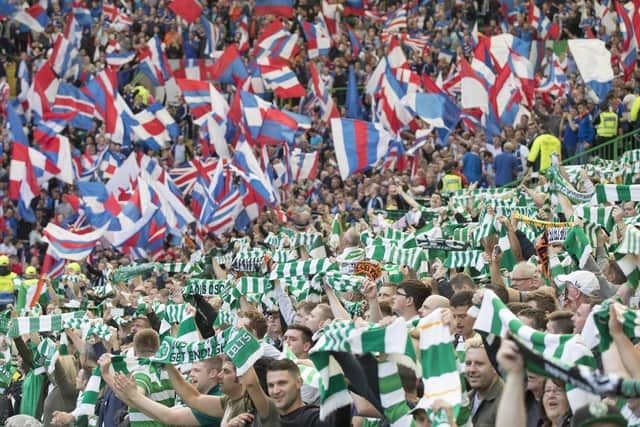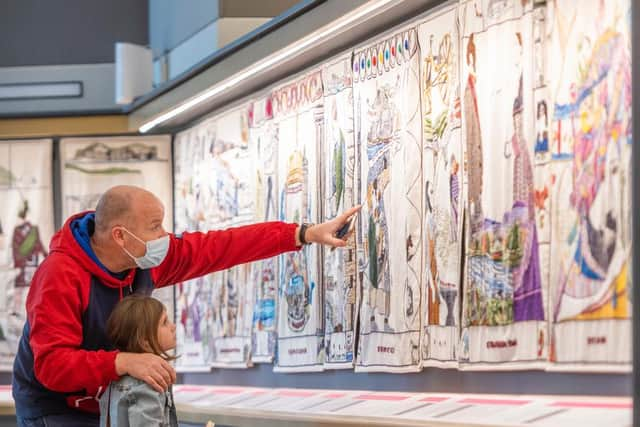The Rangers versus Celtic football rivalry explained - Dr Joseph Bradley
Recognising the importance of events, processes and phases of Scottish/British imperialism, especially in relation to Ireland, contributes to a more informed understanding of the rivalry between Rangers and Celtic, as well as throwing light on contemporary postcolonial, identities in Scotland.
The Great Tapestry – unveiled in 2013 in the Scottish Parliament is a multi-panel representation of Scotland’s history, commissioned and sanctioned by Scotland’s devolved government. Thirty-four thousand visitors initially attended its display, and many more in later exhibitions around the country. However, its minor reference to football in Scotland reflected how dominant representations of the so called ‘Old Firm’ betrays an ignorance of that very subject.
Advertisement
Hide AdAdvertisement
Hide AdThe Great Tapestry of Scotland journeys from the first millennium to the Scottish Protestant Reformation of the 1560s, and from that epochal event to the creation of the Scottish Parliament in 1999. Among hundreds of imaginative images two reference football. The first international football match played between Scotland and England in 1872 is mentioned and recognition is given to some of Scotland’s oldest soccer clubs. Rangers (1872) and Celtic (1887–88) are on a panel alongside a note about the first ‘Old Firm’ match in 1888.


One of the two panels incorporates a note about the country’s single largest ethno-religious community: Irish refugees arriving in Scotland [mainly] as a consequence of the ‘Great Hunger’ of 1845-51. However, its title offers an indication of a much wider issue regarding interpretations of parts of Scotland’s modern history. The title, ‘Irish Immigration after the Famine: Founding of Celtic and Rangers Football Clubs’. This directs viewers towards Ireland for the explanation and cause for ‘sectarianism’ in Scotland.
Framing the roots, cultures and identities of both Celtic and Rangers as originating from Ireland, and what are constructed as ‘Irish’ events, is highly misleading and dishonest. In actual fact, Rangers emerged from within Scotland’s indigenous community via the energies and initiatives of football enthusiasts’ native to Scotland. The relevance of the Great Hunger to sport in Scotland lies mainly in the emergence of Celtic, who grew to become the pre-eminent football club of the Irish-Catholic diaspora there and elsewhere.
It is clear the narrative affirmed in the Great Tapestry of Scotland reflects and reproduces a conventional and influential construction of the history of Celtic and Rangers together as the ‘Old Firm’. Significantly, this points primarily to Ireland as the source of Scotland’s ethno-religious complexity and ‘problems’, informing and reflecting wider media and political interpretations and constructions of ‘sectarianism’ in society. So, for example several years ago an MSP stated that, ‘sectarianism’ in Scotland was ‘born out of the history of Ireland’. One of the country’s main broadsheet newspapers said that ‘sectarianism’ in Scotland was a mindset rooted in the poverty and violence of Northern Ireland, ‘imported to the west of Scotland by 19th century migrants’.
The Great Tapestry, with validation offered by the Scottish government, much advocated in the popular press, displayed in several mass exhibitions, and visited by many people, including tens of thousands of school children, enshrines, and educates with respect to, a version of the past by offering particular representations of modern Scottish football history. More broadly, reflecting the narrative of sectarianism, the tapestry reiterates and promotes the received wisdom that the source of Scotland’s ethno-religious, cultural, community and football problems lies outside of Scotland, that is, in Ireland.


The tapestry mentions Ireland one more time. Entitled ‘The Dawn of the Ulster Scots’, this panel makes brief reference to the dispossession ‘through opportunism and influence’ of Irish chieftain Con O’Neill, who was facing execution for ‘alleged rebellion against the Crown’ and ‘Scotland’s first colony’ being set up across the Irish Sea. Thus, Scottish colonisation of north-east Ireland is described in terms of:
thousands of Scots, mainly Protestant farming families from the southwest, ... moving to eastern Ulster to inhabit and cultivate the lands given up by O’Neill … the Protestant Plantation of the rest of Ulster then began in 1610.
Scotland and England’s military conquest of Ulster’s nine counties is thus passively summarised. No mention either of the significant emergence of the Loyal Orange Institution arising from the colonisation of Ireland. Indeed, as one of Scotland’s most numerically and symbolically significant, and long lasting social, cultural, political and religious bodies, the absence of the LOL represents a huge omission on the Tapestry. It is for such reasons that we need to look to other sources to acquire deeper insights and knowledge regarding the role of Scots in conquering and colonising Ireland and the significance for this today.
Advertisement
Hide AdAdvertisement
Hide AdSo, for instance, academic Suzanne Audrey notes that the Scottish colonisers were offered favourable terms ‘in exchange for swearing allegiance to the Crown and agreeing not to inter-marry or learn the language of the native Irish’. Irish Catholics ‘were driven off their land and forced to starve or emigrate’: Historian A.T.Q. Stewart claims ‘the core of the Ulster problem is the problem of the Scots’. Later, after Ulster was conquered, settled and controlled (most of the rest of Ireland had already been conquered), many Scottish-British colonists, referred to as ‘Scots-Irish’ and ‘Ulster-Scots’, left frontier Ulster for North America, where they became central to the European colonial enterprise that would become the United States of America: in the process producing many future presidents.


Collective historical memories contribute to the formation of narratives around football. Scotland against England, Iran versus the United States, and the rivalry between Argentina and England are only some examples where historical memories play a role. We can also note that relevant memories, identities, songs and chants don’t mysteriously appear in football. Relevant banners, flags and chants at Scottish international matches referencing 14th-century Scottish historical events, figures and battles, and a range of other such examples from across the global game, reveal the importance of socio-cultural, political memories and histories to numerous football rivalries.
History and how it is viewed and represented is contested terrain, in football as elsewhere. In relation to popular accounts of this great ‘football’ rivalry, in Scotland there is a customary failure to explore, explain and recognise distinctive as well as interrelated club, supporter and wider histories and identities. As observed with world-famous Catalan football club Barcelona, significance on the football field is constituted for supporters and society via cultural, religious, political, ethnic and national contexts and histories. It is such complex interweaving that helps explain the meaningfulness and symbolism of these two football institutions, as well as the contest between and around them. This rivalry speaks to the context of British colonialism in Ireland, which has contributed to the mosaic that comprises life in Scotland. This becomes publicly manifest and evident in the country’s football environment, particularly as witnessed around Celtic and Rangers.
Comments
Want to join the conversation? Please or to comment on this article.